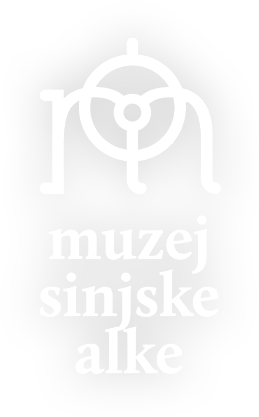



The alkars’ uniforms originate from the folk costumes of the local upper classes that were worn up to the first half of the 19th century, while also drawing influences from the riding and military uniforms of the same period. They are the only costumes or uniforms of this kind and of this age in Croatia that have remained authentically preserved, and they are also a rarity even in a broader European context.
On the head, the alkars wear a marten fur busby with a plume ("penoć"), while their body is dressed in a dolman and trousers ("gaće") made from fine baize decorated with embroidery and decorative silver buttons on the front of the dolman. As underclothes, they wear a brocade waistcoat ("krožet") with decorative gold or silver buttons, under which they wear a cotton or linen shirt (in the past, they would wear a "peturin" that consisted of a collar and plastron), with decorative cufflinks on the collar, and a colourful silk girdle worn over it. Their riding boots are decorated with a gold or silver ribbon ("galun") with a tassel on the boot-leg. The uniform, i.e. the dolman and the trousers of the alkar are deep blue, with ornaments in several patterns and with different combinations of pattern and colour on their waistcoats and girdles. The duke’s uniform distinguishes itself by being brown, and it is particularly lavishly decorated with gold embroidery, gold buttons and tassels and a waistcoat made of red velvet with gold embroidery. The commander’s uniform, which is black, instead of a dolman has a short fur-trimmed dolman ("dolamica") that reaches to the waist, while his waistcoat is made from white baize and decorated with slanted rows of small silver half-buttons.
The apparel worn by the alkar’s squires represents the most ceremonial form of men’s folk costume of the Cetina region which, as a living costume, survived in various forms all the way up to the mid-20th century. Apart from at the Alka, this costume can also be seen at the performances of folk ensembles from the Cetina region and on certain individual performers. The costume of the alkar’s squires is the oldest form of costume that has remained preserved and dates back to the early 20th century , and it is also worn according to stricter rules, which gives it some of the characteristics of a uniform.
On their heads, the alkar’s squires wear a red cap wrapped in a decorative scarf ("peškir") and with a bunch of flowers stuck into it. On their body, over a white wide-sleeved cotton or linen shirt with narrow cuffs, they wear a waistcoat made of red baize decorated with metal, silver or gold buttons, together with blue trousers ("gaće") with decorative buttons on the slit at the lower end of the back of their trouser legs and a red girdle. The jacket ("kumparan") is not worn, but instead is thrown over the left shoulder and secured with a tie hanging from the neck (the Edek guides, shield bearer and mace bearers do not have a jacket). On their feet, over knitted woollen and embroidered oversocks ("terluci"), they wear light peasant shoes. The uniform of the chieftain of the alkar’s squires is more lavish and is made from fine wool fabric, with a larger silk peškir on the head and an additional silk girdle. Special, more lavish details are also worn by the chieftain’s deputy and the "prvari" (the first two squires heading the column of two).
Since end of the second half of the 20th century, when the Alka of Sinj was declared a zero-category national cultural good, the creation of new uniforms and costumes and the preservation of old ones is guided by the recommendations of an expert committee of the time, while also involving the participation of the Croatian Conservation Institute.